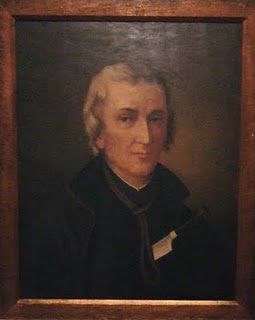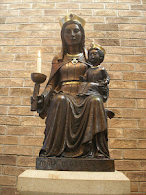 In 1580, Durante Alberti painted “The Martyrs’ Picture” which hangs in the College Chapel. The painting depicts the Holy Trinity with two English Martyrs, St Edmund and St Thomas Becket. A map of the British Isles lies below the crucified Christ and blood from his wounds drops onto the map. Fire springs from the droplets of blood. This echoes the college motto, held by a cherub, “Ignem veni mittere in terram”, “I have come to bring fire to the earth”. (The picture above is a copy which is in the Chapel at Tyburn Convent, London)
In 1580, Durante Alberti painted “The Martyrs’ Picture” which hangs in the College Chapel. The painting depicts the Holy Trinity with two English Martyrs, St Edmund and St Thomas Becket. A map of the British Isles lies below the crucified Christ and blood from his wounds drops onto the map. Fire springs from the droplets of blood. This echoes the college motto, held by a cherub, “Ignem veni mittere in terram”, “I have come to bring fire to the earth”. (The picture above is a copy which is in the Chapel at Tyburn Convent, London)Upon receiving news of the martyrdom of one of its alumni, the students began the practice of gathering around the picture to sing a Te Deum. This practice continues still and each year on ‘Martyrs’ Day’, 1st December, the students gather to sing a Te Deum in front of the painting and the relics of the Martyrs, preserved beneath the altar, are venerated by the students.
 St Edmund is the English Martyr portrayed on the right. Edmund was King of East Anglia. He was born about 840 and he was a Christian from infancy. Although only about 15 years old when he was crowned, the young King showed himself to be an exemplary ruler, strong in his faith, prayerful, and determined to treat all justly. It is said that he retired to his royal tower at Hunstanton and spent a year in prayer. He learned the whole Psalter by heart so that thereafter he could recite it regularly.
St Edmund is the English Martyr portrayed on the right. Edmund was King of East Anglia. He was born about 840 and he was a Christian from infancy. Although only about 15 years old when he was crowned, the young King showed himself to be an exemplary ruler, strong in his faith, prayerful, and determined to treat all justly. It is said that he retired to his royal tower at Hunstanton and spent a year in prayer. He learned the whole Psalter by heart so that thereafter he could recite it regularly.In 870, some say 869, Edmund’s kingdom was invaded by a great Viking army. Edmund marched out at the head of his army and the Danes were repulsed. The invaders soon returned with overwhelming numbers. The King, in order to avert a fruitless massacre, disbanded his troops and he retired towards Framlingham. Unfortunately, he fell into the hands of the invaders. In captivity he was ordered to renounce his faith and become a vassal of the Danes. King Edmund rejected all their wicked demands declaring that his religion was dearer to him than his life!
Infuriated by the King’s fidelity, his cruel captors beat him with cudgels then tied him to a tree where they tore his flesh with whips. Through all his agony, Edmund continued to call upon the name of Jesus. His enraged persecutors next unleashed a hail of arrows upon his tortured body. Seeing that Edmund could not be swayed, they beheaded him.
Edmund’s martyrdom took place in Hoxne, Suffolk, in 870. In 915 his body was found to be still incorrupt and his remains were translated to Bedricsworth, since renamed Bury St Edmunds. His reputation grew and his shrine soon became one of the most famous pilgrimage sites in England. The date of his canonisation is unknown but it is thought to be sometime between 924 and 939. Many churches and colleges were named after St Edmund. He was adopted as the Patron Saint of England and a banner bearing Edmund’s crest was carried at the Battle of Agincourt. Predictably, his shrine was pillaged in 1539 on the orders of King Henry VIII.
Although St Edmund, King and Martyr, has been replaced as Patron Saint of England by St George, this truly English Saint is venerated in the Orthodox, Catholic and Anglican traditions. His feast day, regrettably now relegated to an optional memorial, is 20th November.
LINKS TO THIS POST:








.JPG)

.JPG)






Always enjoy your posts and learn so much. Wishing you and your family a blessed Christmas.
ReplyDeleteGreat post, thanks Breadgirl and a Happy and Holy Christmas to you both.
ReplyDeleteHello Buttercup,
ReplyDeleteI am glad you enjoy the posts. Thank you for saying so. It is appreciated. I hope you & your loved ones have a happy Christmas & a peaceful, healthy 2012.
God bless you.
Hello Richard
ReplyDeleteThank you for that nice comment. Thanks too for being so faithful & supportive. I wish you & your family a very Happy Christmas & many blessings in 2012.
God bless you.